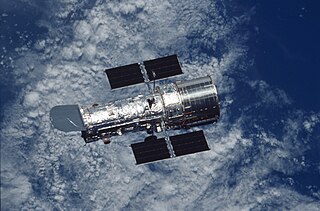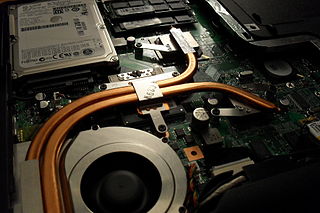Related Research Articles
A lubricant is a substance that helps to reduce friction between surfaces in mutual contact, which ultimately reduces the heat generated when the surfaces move. It may also have the function of transmitting forces, transporting foreign particles, or heating or cooling the surfaces. The property of reducing friction is known as lubricity.

Solar sails are a method of spacecraft propulsion using radiation pressure exerted by sunlight on large surfaces. A number of spaceflight missions to test solar propulsion and navigation have been proposed since the 1980s. The first spacecraft to make use of the technology was IKAROS, launched in 2010.

Heat transfer is a discipline of thermal engineering that concerns the generation, use, conversion, and exchange of thermal energy (heat) between physical systems. Heat transfer is classified into various mechanisms, such as thermal conduction, thermal convection, thermal radiation, and transfer of energy by phase changes. Engineers also consider the transfer of mass of differing chemical species, either cold or hot, to achieve heat transfer. While these mechanisms have distinct characteristics, they often occur simultaneously in the same system.

Astronautics is the practice of sending spacecraft beyond Earth's atmosphere into outer space. Spaceflight is one of its main applications and space science is its overarching field.

Wear is the damaging, gradual removal or deformation of material at solid surfaces. Causes of wear can be mechanical or chemical. The study of wear and related processes is referred to as tribology.
Tribology is the science and engineering of understanding friction, lubrication and wear phenomena for interacting surfaces in relative motion. It is highly interdisciplinary, drawing on many academic fields, including physics, chemistry, materials science, mathematics, biology and engineering. The fundamental objects of study in tribology are tribosystems, which are physical systems of contacting surfaces. Subfields of tribology include biotribology, nanotribology and space tribology. It is also related to other areas such as the coupling of corrosion and tribology in tribocorrosion and the contact mechanics of how surfaces in contact deform. Approximately 20% of the total energy expenditure of the world is due to the impact of friction and wear in the transportation, manufacturing, power generation, and residential sectors.

A heat pipe is a heat-transfer device that employs phase transition to transfer heat between two solid interfaces.
Outgassing is the release of a gas that was dissolved, trapped, frozen, or absorbed in some material. Outgassing can include sublimation and evaporation, as well as desorption, seepage from cracks or internal volumes, and gaseous products of slow chemical reactions. Boiling is generally thought of as a separate phenomenon from outgassing because it consists of a phase transition of a liquid into a vapor of the same substance.
A coolant is a substance, typically liquid, that is used to reduce or regulate the temperature of a system. An ideal coolant has high thermal capacity, low viscosity, is low-cost, non-toxic, chemically inert and neither causes nor promotes corrosion of the cooling system. Some applications also require the coolant to be an electrical insulator.
Grease is a solid or semisolid lubricant formed as a dispersion of thickening agents in a liquid lubricant. Grease generally consists of a soap emulsified with mineral or vegetable oil.
Corrosion in space is the corrosion of materials occurring in outer space. Instead of moisture and oxygen acting as the primary corrosion causes, the materials exposed to outer space are subjected to vacuum, bombardment by ultraviolet and X-rays, and high-energy charged particles. In the upper layers of the atmosphere, the atmospheric atoms, ions, and free radicals, most notably atomic oxygen, play a major role. The concentration of atomic oxygen depends on altitude and solar activity, as the bursts of ultraviolet radiation cause photodissociation of molecular oxygen. Between 160 and 560 km, the atmosphere consists of about 90% atomic oxygen.

Phenyl ether polymers are a class of polymers that contain a phenoxy or a thiophenoxy group as the repeating group in ether linkages. Commercial phenyl ether polymers belong to two chemical classes: polyphenyl ethers (PPEs) and polyphenylene oxides (PPOs). The phenoxy groups in the former class of polymers do not contain any substituents whereas those in the latter class contain 2 to 4 alkyl groups on the phenyl ring. The structure of an oxygen-containing PPE is provided in Figure 1 and that of a 2, 6-xylenol derived PPO is shown in Figure 2. Either class can have the oxygen atoms attached at various positions around the rings.
Oil additives are chemical compounds that improve the lubricant performance of base oil. The manufacturer of many different oils can utilize the same base stock for each formulation and can choose different additives for each specific application. Additives comprise up to 5% by weight of some oils.
The Stribeck curve is a fundamental concept in the field of tribology. It shows that friction in fluid-lubricated contacts is a non-linear function of the contact load, the lubricant viscosity and the lubricant entrainment speed. The discovery and underlying research is usually attributed to Richard Stribeck and Mayo D. Hersey, who studied friction in journal bearings for railway wagon applications during the first half of the 20th century; however, other researchers have arrived at similar conclusions before. The mechanisms along the Stribeck curve have been understood today also on the atomistic level.
Dry lubricants or solid lubricants are materials that, despite being in the solid phase, are able to reduce friction between two surfaces sliding against each other without the need for a liquid oil medium.
Chameleon coating, also known as nano composite tribological coating, is an adaptive adhesive that uses nanotechnology to adjust to environmental fluctuations to make living conditions more suitable to the object that the coat has been applied to.

Materials for use in vacuum are materials that show very low rates of outgassing in vacuum and, where applicable, are tolerant to bake-out temperatures. The requirements grow increasingly stringent with the desired degree of vacuum to be achieved in the vacuum chamber. The materials can produce gas by several mechanisms. Molecules of gases and water can be adsorbed on the material surface. Materials may sublimate in vacuum. Or the gases can be released from porous materials or from cracks and crevices. Traces of lubricants, residues from machining, can be present on the surfaces. A specific risk is outgassing of solvents absorbed in plastics after cleaning.

In spacecraft design, the function of the thermal control system (TCS) is to keep all the spacecraft's component systems within acceptable temperature ranges during all mission phases. It must cope with the external environment, which can vary in a wide range as the spacecraft is exposed to the extreme coldness found in the shadows of deep space or to the intense heat found in the unfiltered direct sunlight of outer space. A TCS must also moderate the internal heat generated by the operation of the spacecraft it serves.
Tribofilms are films that form on tribologically stressed surfaces. Tribofilms are mostly solid surface films that result from a chemical reaction of lubricant components or tribological surfaces.
Extreme tribology refers to tribological situations under extreme operating conditions which can be related to high loads and/or temperatures, or severe environments. Also, they may be related to high transitory contact conditions, or to situations with near-impossible monitoring and maintenance opportunities. In general, extreme conditions can typically be categorized as involving abnormally high or excessive exposure to e.g. cold, heat, pressure, vacuum, voltage, corrosive chemicals, vibration, or dust. The extreme conditions should include any device or system requiring a lubricant operating under any of the following conditions:
References
- ↑ W.R. Jones Jr.; M.J. Jansen (2000). "Space Tribology" (PDF). Nasa/Tm-2000-209924.
- 1 2 3 4 5 Roberts, E W (2012). "Space tribology: its role in spacecraft mechanisms". Journal of Physics D: Applied Physics. 45 (50): 503001. Bibcode:2012JPhD...45X3001R. doi:10.1088/0022-3727/45/50/503001. S2CID 120418746.
- ↑ Aglietti, Guglielmo S. (2011). "Spacecraft Mechanisms". In Fortescue, Peter; Swinerd, Graham; Stark, John (eds.). Spacecraft Systems Engineering. John Wiley & Sons, Ltd. pp. 495–526. doi:10.1002/9781119971009.ch15. ISBN 978-1-119-97100-9.
Ahmed Abdelbary, (2020). Extreme Tribology: Fundamentals and Challenges, Boca Raton: CRC Press, ISBN 978-0-429-44886-7. doi : 10.1201/9780429448867.